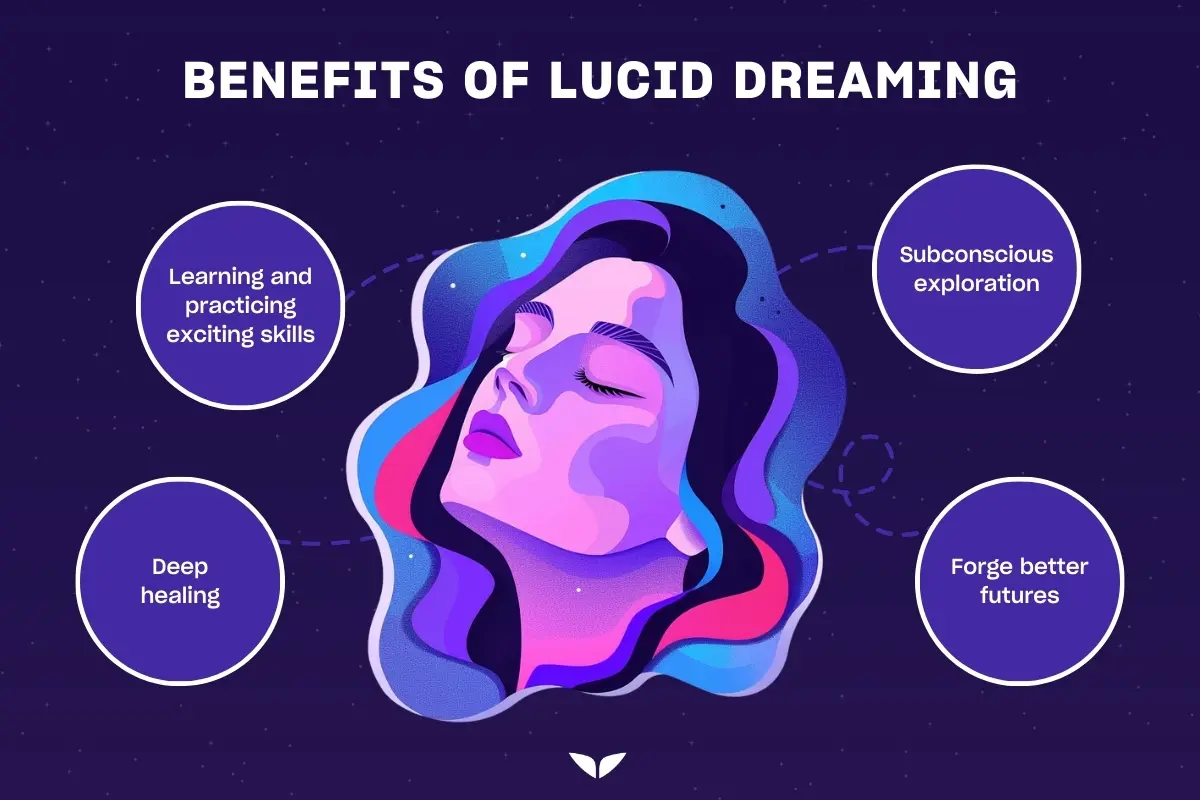One undeniably mysterious part of our psyche is the dimension of our dreams. And when you discover how to lucid dream, you will reach an exciting new level of exploration in your reality.
Lucid dreaming is a safe space within your being where it’s possible to live out the experiences you’ve always dreamed of. Literally.
This article is inspired by Charlie Morley, a globally celebrated lucid dreaming teacher. Teaching how to lucid dream in some of the greatest institutions in the world, he has partnered up with Mindvalley to share his knowledge in the unique Experience Lucid Dreaming Quest.
Any Aerosmith fans out there? Let’s dream on.
What is lucid dreaming?
Simply put, lucid dreaming is being lucid, a.k.a., fully aware, during a dream. The term ‘lucidity’ is defined as clarity of thought and is often linked to the capacity to see the real truth of your current experience.
This makes it very exciting to experiment with.
Imagine a world where you could conquer your biggest fears, travel to any location on the planet, and live out awesome adventures and fantasies.
You can experience this new realm actively or passively. The most popular type of lucid dreaming involves active participation, where you create and control your dreams, which is what will be covered in this article.
A great, very simple way to discover if you’ve ended up in a lucid dream is to ask yourself if you’re in one.
Think of it like this: Are you aware right now? Are you conscious?
If the answer is yes, then you are lucid as you read these words. If you can ask yourself a similar question while in dreamland and answer it, then you’ve accomplished your goal.
You are one with everything in a lucid dream and everything in the dream is you.
— Charlie Morley, trainer of Mindvalley’s Experience Lucid Dreaming Quest
What does lucid dreaming feel like?
How do you feel when you see a sunrise? Hear your favorite song? Smell a rose? Eat your mom’s famous pot roast? Pet your dog?
Now, imagine those feelings amplified. That is what it feels like.
Even though you’re aware that you’re in a dream state, it’s often extremely vivid and feels very real.
Everything is heightened, including your five senses: sight, sound, smell, taste, and touch. Your emotions can feel more intense than they normally feel in the real world.
While you can feel a greater sense of joy, love, and all things wonderful, bear in mind that you can also feel a greater sense of the negative ones. So take care of how you plan your dreams. So take care of how you plan your dreams by learning how to lucid dream.
Lucid dreaming is essentially a reality you create, where you can sense and feel everything around you within the safe construct of your mind.
What can you do in a lucid dream?
Anything you like! But if you’re strapped for ideas, here are some for your next plan:
- Traveling to a country you’ve always wanted to visit.
- Flying over planet Earth from the stars.
- Practicing meditation for an extra layer of consciousness.
- Meeting your inner child.
- Having a cup of tea with your older and wiser self.
- Scuba diving without a tank (and being able to breathe).
- Shapeshifting into your favorite wild animal.
- Talking with aliens.
- Winning a Golden Ticket and taking a tour of Willy Wonka’s Chocolate Factory.
- Simply shouting out during the dream: “Show me something AWESOME!”
How to lucid dream in 4 simple steps
If you want to learn how to control your dreams, you should start with these four methods. It will take a little practice, though.
If it were just as simple as going to sleep and remembering that you’re not awake, there wouldn’t be an ever-growing collection of masterclasses, courses, and blogs covering all the varying techniques out there, of which there are many.
That said, this is possible for anyone and everyone. To get started, follow our four favorite tips to make sure you regain or maintain awareness as you enter REM sleep. They really do work, so give them a shot and perhaps discover how to lucid dream tonight.
Step 1. The reality testing technique
Reality testing, also known as reality checking, is an effective type of mental training to build lucid dreamer muscles. It increases metacognition (the ability to think or notice one’s thinking) by slowly but surely training your mind to notice your awareness.
Metacognition is similar to the concepts of mindfulness and meditation…but with an interdimensional, lucid twist.
Reality checks increase lucidity because the more developed your metacognitive skills are when you’re awake, the more developed your metacognitive skills will be when you’re dreaming.
When you do a reality check very often during the day, your subconscious will program the awareness practice in your mind. When reality testing becomes a subconscious habit, you will better be able to do reality checks and spot dream signs during your dream.
For example, in The Matrix, looking at a spoon is Neo’s reality check. He says, “There is no spoon” and watches it melt. That way, he roots into his lucid awareness and knows he’s in the Matrix (equivalent to dreaming).
For this step, Charlie recommends doing The Weird Technique in your waking state to achieve lucidity during the night. The way it works is by acknowledging every time something weird happens around you and asking yourself, “Am I dreaming?”
Then look at your hand twice in a row and become aware of its details. A bit weird, right? This exercise aims to practice becoming aware in your real life, so your brain gets the momentum of lucidity in your dreams.
Step 2. Keep a dream journal
Make an effort to wake up in the morning to instantly write down everything you can remember about your dreams. Among the benefits of doing so is lucid dreaming facilitation.
The more attention you give to your dreams, the more you train your brain to recognize them as very important. Thus, you will start to remember your dreams better, which means your dream lucidity will increase.
Having a dream journal will also help you recognize repeating patterns in your dreams. When you are aware of these patterns, you will also be able to recognize them faster and easier during a dream.
Instead of opting for your phone, write in a notebook that you keep by your bed. That’s because the act of turning on your phone, finding the notes section, and looking for the letters on your screen can pull you out of the post-dream state too much, consequently making you forget the details of a dream.
If you remember a lot of it, write down the key details first, and then flesh out those details as much as possible. Stretch yourself. It’s important to write down as much information as you can before your mind awakens completely.
Step 3. The “Wake Back to Bed” technique
The intention behind using the ‘Wake Back to Bed’ (WBTB) technique is to enter REM sleep while you’re still kind of conscious. This makes it way easier for you to control your dreams.
There are five steps to the WBTB hack:
- Set an alarm for five hours after you go to bed.
- Go to sleep.
- When the alarm goes off, try not to get too angry and stay alert for 15–30 minutes. You may meditate, read, or listen to gentle binaural sounds at this time (many say binaural beats help them have lucid dreams).
- Fall back asleep.
- When you go back to sleep, you’ll be a lot more likely to have vivid dreams. Look out for dream signs.
Step 4. Create a dream plan
If you’d like, you can use the same dream journal from Step 2 for this step too. This time, the idea is to write down what you want to dream about before you go to sleep.
Start the entry by stating, “In my next lucid dream, I will…” and describe what will happen, how it will feel, and how exactly it will end.
The intention you set, before you close your eyes, will leave a subtle imprint on your subconscious mind, making it way more likely that you will achieve whatever you want to achieve while lucid dreaming.
There are a whole host of exciting things you can do here, and your imagination is your limit. Many people meditate to tune into their intuition and ask what may most serve them personally in this kind of experience.
Astral projection vs. lucid dreaming
The key difference between astral projection and lucid dreaming is how you reach each state.
While lucid dreaming occurs when the conscious mind is activated during your sleep, astral projection is an out-of-body experience that can occur while you’re awake.
One main thing to understand about astral projection is that, according to legend, advanced astral travelers can venture into other worlds and spiritual realms.
Exploring astral projection and playing around with out-of-body experiences can be super fun and mind-opening, but mastering how to lucid dreams is more for beginners. We wouldn’t want you floating off into another dimension without the right training first.
Benefits of lucid dreaming
Apart from being incredibly fun, when you learn how to have a lucid dream, you’ll get some awesome advantages. Here are Mindvalley’s top four proven benefits:

1. Deep healing
The official European Science Foundation Gathering of 2009 concluded that lucid dreaming is no doubt a powerful tool for treating neurological and psychiatric disorders.
As trauma often manifests in the dream state as well as the waking state, lucid dreaming may act as one of the most empowering interventions possible when it comes to healing.
During this fascinating experience, the prefrontal cortex of the brain, which contributes to learning and personality development, becomes activated. What’s even more exciting is that neuroplasticity is engaged just like it is in the waking state.
This allows you to rewire your brain while you’re sleeping.
Moreover, studies show that it can be excellent at decreasing the frequency of traumatic nightmares.
Charlie confirms that lucid dreaming is excellent for trauma integration. After having taught hundreds of people suffering from PTSD, from war veterans to child abuse victims, he has seen its potency firsthand.
Learn more: 3 Alternative Methods for PTSD & Healing From Trauma: The Latest Research
2. Subconscious exploration
Lucid dreaming also opens the gateway to subconscious negative beliefs that are hidden from the conscious mind.
This is exciting because our subconscious beliefs shape our realities through our thoughts, feelings, and behaviors. So just imagine what you could do if you were to see them in front of you in a lucid dream.
Through this dreaming method, you can consciously choose to face your fears or any limiting beliefs so you can transform them. You can even come to understand how they got there in the first place.
A classic example of a subconscious belief-driven fear is suffering from arachnophobia (an irrational fear of spiders and other arachnids such as scorpions).
During a lucid dream, there’s nothing to stop you from calling in a friendly spider, one that’s small and unthreatening, to begin the transformational process step by step.
You can even commence a dialogue with it to ask where the origins of your fear lie and how to come to peace with the creatures.
Many people end up resolving deep personal issues during lucid dreams without ever having to step foot in a professional hypnotherapy session.
Having taken the quest I realize that becoming lucid is a gift and that taking notice of the dream, listening to the dream’s message and embracing it is very powerful. It has opened my eyes to a completely new and incredibly effective way of healing previous trauma.
— Stella, RTT therapist from France
3. Learning and practicing exciting skills
Yes, that’s right. You can practice any desired skill in your sleep.
You see, the brain doesn’t know the difference between actively imagining you’re doing something and actually doing it. It’s become really popular to visualize the act of practicing a skill, say, playing the piano. And it works.
But lucid dreaming takes you to the next level. You could find yourself in a complete, moving 3D visualization, one that works naturally and with 100% efficacy.
And the results are real.
Studies continue to show that discovering how to lucid dream can be used as a great training method for athletes too.
Charlie shares that in a study carried out by Heidelberg University back in 2019, martial artists were asked to practice a specific kickboxing sequence in their lucid dreams.
Fascinatingly, in the waking state, he disclosed that 81.3% of them actively improved their martial arts practice. So lucid dreaming practices can indeed lead to physical waking state results.
From getting better at creative problem-solving to enhanced self-reflection and consciousness, it acts as the ultimate brain gym.
4. Forge better futures
Charlie also explains that lucid dreaming can be a powerful self-development tool for real-life manifestation.
Within your dream, you are given the space to ask big questions such as:
- What is the meaning of my life?
- What do I want out of life?
Listen up, because you’ll probably get big answers. In this state, we get access to the whole truth and nothing but the truth and the information we receive is unfiltered by external pressures.
This is one of the core benefits of lucid dreaming, making friends with ourselves.
— Charlie Morley, trainer of Mindvalley’s Experience Lucid Dreaming Quest
Once you identify what it is you truly want out of life, you can then start to literally live your dreams. If what you want is to become a world-class writer, explore writing a New York Times best-seller in your dreams.
Allow yourself to feel the feelings of excitement and achievement as your book gets published. This is the Law of Attraction at its finest.
Your subconscious mind doesn’t understand the difference between your dream state and your reality, so what better way to prepare for a better future and actively attract it to you?
Lucid dreaming can give us all the tools we need to resolve our problems, achieve emotional balance, liberate us from the potential prison of the mind, perfect our talents, and attract the lives of our…dreams!
Learn more: The Benefits of Lucid Dreaming, According to Science
Debunking lucid dreaming myths
There are a few myths about lucid dreaming that should be highlighted. A few have subtle elements of truth to them, and others are lies. Here are three common myths debunked:
1. You might never wake up from a lucid dream
What if you can’t wake up from a lucid dream? This is the one question that puts most people off attempting a lucid dream. But it’s simply not true.
You can and WILL wake up. And if you happen to experience a slight glitch in the sleep-wake process, it will pass quickly.
Still a little doubtful? Learn how to stay safe.
2. Lucid dreaming can be very risky
Are lucid dreams dangerous? Simply put, no.
Lucid dreams may feel dangerous (you may feel doubtful or fearful during a dream), but in reality, you’re perfectly safe. You have nothing to fear. Nobody has ever died or gotten injured during a lucid dream.
Remember, you’re the one in control. Harness the power of your mind, especially if you feel lost or are experiencing any negative emotion.
Learn more: Is Lucid Dreaming Dangerous? The Truth Unveiled
3. In a lucid dream, you don’t actually rest
Untrue. Although you might feel like you’re scaling a cliff face, running a marathon, skydiving, or flying, remember: it’s just a dream.
For lucid dreaming to occur in the first place, you must enter into a REM sleep cycle, a deep level of rest, so don’t worry. Your body is going to get all the rest it needs, and lucid dreaming is unlikely to cause any major sleep disruptions.
If you’re keen on the idea of deep, restorative sleep that comes easily, consider taking a good-quality melatonin supplement as part of your bedtime routine.

How to stay safe while lucid dreaming
Living your dream, in a manner of speaking, is a fascinating and safe experience and can be very helpful for a lot of people.
There’s a lot of hearsay and fear around whether lucid dreaming is dangerous because some people claim to have experienced false awakenings (the feeling of waking up, but you’re still dreaming) or sleep paralysis (a phenomenon where a person awakens from sleep to find they are unable to move or speak).
This sounds scary and is no doubt unpleasant, but these scenarios can affect anyone at any time, regardless of whether they’re actively practicing lucid dreaming or not.
According to WebMD, sleep paralysis can happen to as many as four people out of every 10, but there’s little evidence to suggest that lucid dreaming is to blame.
If you’re unlucky enough to face these challenges as you sleep, there are ways you can make sure you have a smoother time.
Learn more: Spider-Man’s Tom Holland on Lucid Dreaming and Sleep Paralysis
Tips to keep in mind
Keep these tips in mind, and you’ll do just fine:
- New experiences can be scary, but don’t panic. Remember: it’s just a dream.
- Practice in moderation (especially if you’ve experienced sleep paralysis before).
- Don’t resist. Whatever you experience whilst lucid dreaming, good or bad, give in to the process and trust it’s all going to be fine
- Remember, nobody ever got hurt in a lucid dream, and false awakenings in all their forms never last.
- Be mindful of your dreaming experiences. Meditate and reflect on them afterward, and be sure to reframe them as experiences that aren’t to be feared.
- Refer back to this lucid dreaming guide to put you on track again.
Dream on
The excitement of learning how to lucid dream fast might not let you fall asleep so easily tonight, and we get that.
Once you know that you’re dreaming, you gain access to the world’s most powerful virtual reality simulation—your own subconscious mind.
— Charlie Morley, trainer of Mindvalley’s Experience Lucid Dreaming Quest
Step into your greatness and embark on this unconventional self-discovery journey—quite a dreamy one, some might say. Welcome in.








